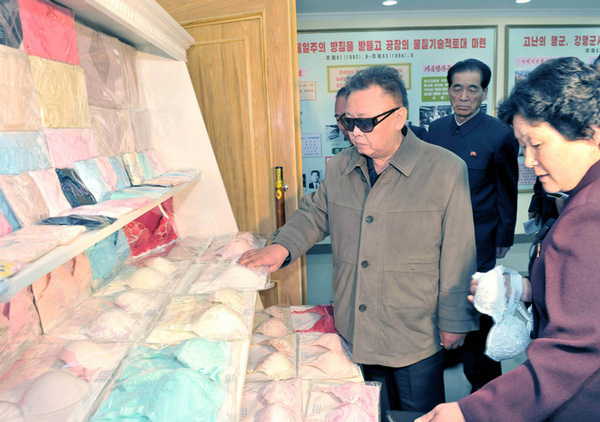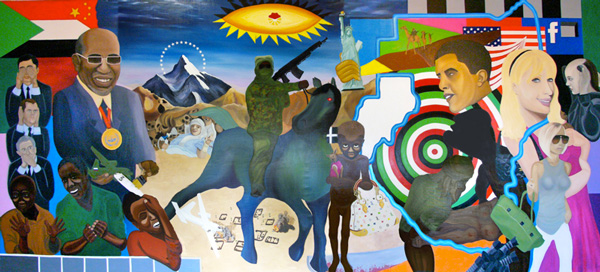The North-Korean government recently released new photos of Kim Jong-il on his never-ending odyssey through his country’s industrial production core. Here we see the great Leader fondling bras. This brings us to the overriding question of whether he would fondle a real breast with the same aloofness if it were covered in plastic? Or – and this is a possibility we must seriously consider – would he first calmly remove the plastic before the arousal of passion would kick in? Let us contemplate this.

Check out an impressive collection of Kim pics at http://kimjongillookingatthings.tumblr.com/

Nadia Plesner (1982), a Danish artist who works and lives in Amsterdam, is currently being sued by luxury giant Louis Vuitton for depicting a so-called “Audra” bag on her epic work Darfurnica. Since January 28 of this year, Plesner has incurred a fine of €5000 a day – now totaling over €440,000 – for refusing to remove the work from her website, and for refusing to stop exhibiting the work in any other form. But by suing Plesner, Louis Vuitton is unduly interfering with the freedom of expression of all artists.

€440,000 – good for only one or two Paris Hilton shopping sprees, but an awful lot of money for a 29-year-old art student. According to Plesner, “Darfurnica is a modern version of Picasso’s Guernica,” the Spanish artist’s famous outcry (1937) against the atrocities of the Spanish Civil War. “What horror,” they must have thought at the Versailles Palace of Louis Vuitton’s legal department. “We don’t want our wonderfully exclusive upscale bags linked to such monstrosities!”
But for Plesner, Darfurnica is not about besmirching Vuitton’s carefully crafted reputation; rather, it is an exploration of the fading boundaries between journalism and advertising, between editorial and commercial content. How come, she asks, trifles about celebs have become breaking news, while a genocide happening somewhere in the world – in Darfur for instance – is not “important” enough to make headlines? “This is unacceptable and I refuse to turn the blind eye to what is happening,” Plesner says on her website.
The question is, why is Louis Vuitton so incredibly finicky about the image of one of its bags appearing in the work of a hitherto unknown artist? Does the company’s legal department believe that the Audra bag’s cameo in Darfurnica will actually damage its sales, reputation, or brand equity?
By suing, the company has opened up a can of worms, launching Plesner – a tiny dauntless David up against a powerful corporate Goliath – into the limelight as a martyr and symbol of artistic freedom and freedom of expression.
In terms of reputation management, the lawsuit is foolish and counterproductive. All the more so considering that Louis Vuitton is not the only brand depicted on Darfurnica – Chanel, Hèrmes, Paramount, Facebook, Victoria Beckham, and the omnipresent Paris Hilton are also featured. Did they sue? Nope.
Without a doubt, Louis Vuitton’s biggest tactical mistake is its failure to recognize that it is not just a brand, but also a cultural icon. In this capacity, Louis Vuitton is not merely the exclusive intellectual property of Louis Vuitton, but also an object in and of the public imagination, and a part of the cultural heritage of our time. Although it is privately owned, its iconic status has transformed it into some sort of public property, and made it an object of artistic sampling – just like Andy Warhol and his Campbell’s soup cans.
Most brands would be happy to reach iconic status, but not Louis Vuitton. The haughty brand, whose ad campaigns boast politically engaged celebrities like Bono and former Soviet leader Michael Gorbachev, has gotten itself into in a street brawl with an art student, whom it is now attempting to squash financially as well as artistically.
But the effort to erase Darfurnica from the public eye only adds insult to injury, as it is an attempt to curb all artists’ freedom of imagination and expression – not exactly the core-business of a luxury brand.
Unlike its counterparts Hèrmes and Chanel, Louis Vuitton overlooked one crucial thing: noblesse oblige.



